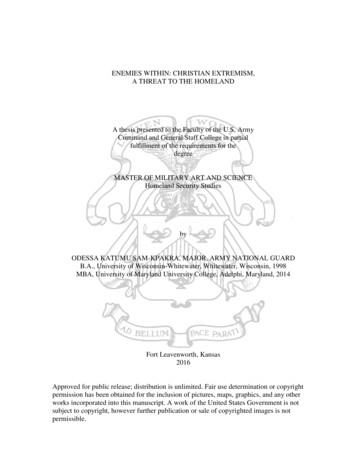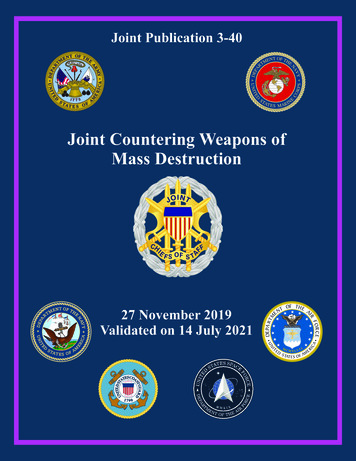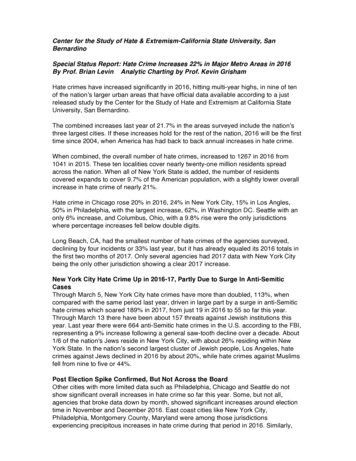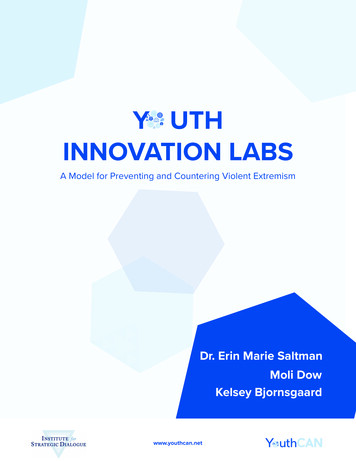
Transcription
MAY 2014Countering Violent Extremism:A Guide for Practitioners and AnalystsA GUIDE
ii
Table of Contents3Definitions of Key Terms4Understanding CVE as a Spectrum of Efforts6Prevention Approaches8Disengagement Approaches11Conceptualizing, Executing, and Monitoring CVE Programs14Building on Existing Programs15TAB A—Funding Strategies for CVE Programs17TAB B—Assessing Risk and Resilience for CVE Planning27TAB C—Summary of the Rome Memorandum on Good Practicesfor Rehabilitation and Reintegration of Violent Extremist Offenders29TAB D—Selected CVE ResourcesCountering Violent Extremism A GUIDETable of Contents1
intentionally left blankCountering Violent Extremism A GUIDE2
Definitions of Key Terms Extremist violence refers to violencecommitted by nonstate actors in thename of a political, ethnic, or ideologicalcause and includes recruiting as well asfacilitating violence.to renounce extremist ideas. This term issometimes used to describe the entireprocess of changing a violent extremist’sattitudes and behaviors and reintegrating himor her into society. Radicalization is the process by whichindividuals come to believe that theirengagement in or facilitation of nonstateviolence to achieve social and political changeis necessary and justified. Rehabilitation repairs an individual’srelationship with society by addressingmaterial needs and imparting new coping andvocational skills to replace socially destructivebehavior patterns. Mobilization is the process by whichradicalized individuals take action to preparefor or engage in violence or material supportfor violence to advance their cause. Reintegration brings an individual back intomainstream society by helping him or herfunction socially and emotionally. Aftercareand monitoring are key components ofreintegration. A violent extremist advocates, is engagedin, or is preparing to engage in ideologicallymotivated violence to further political orsocial objectives. Aftercare encompasses activities that supportdisengagement and new attitudes andbehaviors learned in rehabilitation. Countering violent extremism (CVE)encompasses programs and policies intendedboth to prevent individuals and groups fromradicalizing and mobilizing to commit violenceand to disengage individuals and groups whoare planning to commit, or who have alreadyengaged in, extremist violence. Monitoring is a security component that isoften folded into aftercare but that may be aseparate activity in which family members,NGOs, or law enforcement officers trackindividuals who leave deradicalizationprograms to determine if they are reengagingin extremist activities. Disruption refers to military or lawenforcement actions intended to interruptviolent actions through arrest, deportation, orphysical force. Reengagement occurs when an individualwho has stopped terrorist activities—oftendue to incarceration or involvement in aprogram—returns to these activities. Suchindividuals, particularly when they have beenthrough formal disengagement programs, areoften referred to as recidivists. Diversion refers to programs and activitiesundertaken to change an individual’s trajectoryaway from violent extremism and towardacceptable social behavior. Diversion usuallystarts once an individual has been identifiedas mobilized or preparing to mobilize. Disengagement separates an individual whohas radicalized and mobilized to violence fromengaging in or supporting violent behavior. Deradicalization encourages an individual A community is a residential area—usuallya neighborhood, town, or city—whereindividuals share a common environment.Communities can also include groups ofpeople who share special interests or expressa common religion or ethnicity. Communitiescan also exist in cyberspace and can be asmeaningful to individuals as those in whichthey live physically. Countermessaging involves a concertedeffort to dissuade or reduce an individual’s orgroup’s susceptibility to accepting a narrativeor worldview.Definitions of Key TermsCountering Violent Extremism A GUIDE Resilience refers to the capacity of individualsand communities to manage and overcomeadversity and risk. It is a dynamic conceptassessed by considering the balance of riskand protective factors at a given moment.3
Understanding CVE as a Spectrum of EffortsCVE efforts complement counterterrorism (CT) approaches aimed at disrupting individuals and groupsalready mobilized and committed to violent action. CVE efforts differ from other CT approaches, however,by aiming to have an effect on both the radicalization and mobilization-toward-violence processes at workbefore an individual engages in operational plotting (see graphic, “CVE as a Counter to Radicalization andMobilization”). CVE also seeks to disengage individuals from violence and reintegrate them into society. CVE typically works long term; involves adiversity of departments and agencies workingacross local, state, and federal boundaries;and relies on engaging individual psychology,group dynamics, and public policy to achieveends—the prevention of radicalization andmobilization—not easy to quantify. Because of this complexity, practitioners andanalysts need to appreciate the breadth ofthe CVE spectrum to recognize the strengths,limitations, and challenges associated withany particular programmatic component. Suchan appreciation will aid in better situatingCVE within the overall context of CT policy,as well as provide precision in identifyingexactly what issues need to be addressed.It could also help shape public expectations,foster transparency, and help governmentsdemonstrate measureable success inpreventing and countering terrorism.Countering Violent Extremism A GUIDE4 The complexity of the CVE process issomewhat mitigated by the fact that manyof the programs that can be useful for CVEalready exist for other purposes, such asreducing delinquency, countering gangs,and preventing violence. Understanding theCVE spectrum can help in incorporating CVEgoals into such existing programs, rather thanhaving to create new programs from scratch.In broad terms, the CVE spectrum can be brokendown into prevention and disengagementcomponents. The first aims to prevent individualsfrom becoming radicalized or mobilized towardviolence, while the latter seeks to disengagethose who are already radicalized or mobilizedand to reintegrate former violent extremistsinto society. Prevention approaches broadlyUnderstanding CVE as a Spectrum of EffortsSpectrum of CT StrategiesPREVENTION» Public Policy» Social Programs» Economic Development» Civic Engagement» Public MessagingDISENGAGEMENT» Diversion» Deradicalization» Rehabilitation» ReintegrationDISRUPTION» Arrest» Incarceration» Prosecutionaddress the individual, group, community,sociopolitical, and ideological factors associatedwith radicalization. Disengagement approachestend to focus on individuals who have alreadymobilized to act by reducing the contributingfactors, inhibiting behavior, and focusing onchanging patterns of mobilized behavior. In thegraphic, “CVE as a Counter to Radicalizationand Mobilization,” CVE efforts addressing thetop circle, radicalization, fall primarily in theprevention range of the CVE spectrum, whileefforts to address the mobilization and actioncircles would fall in the disengagement range ofthe CVE spectrum.
CVE as a Counter to Radicalization and Mobilization Toward ViolencePersonal Factors Personal needs Personal contextGroup Factors Collective identity Peer networkCommunity Factors Insularity MarginalityRadicalizationThe process by whichindividuals come to believethat their engagement in orfacilitation of nonstateviolence to achieve socialand political change isnecessary and justifiedCatalysts Social media Encouragement by family and friendsSociopolitical Factors PERISTION OF CRCEPReadiness To ActIS Grievances Global incidentsPreventionRadicalization and mobilization toward violence are dynamic, not linear processes. CVE aims to: Mitigate factors that contribute to radicalization, Enhance factors that act as inhibitors to radicalization and mobilization toward violence, and Foster individual and community resilience to radical thought and action.Ideological Factors Influential ideologues Claim to exclusive authorityInhibitors Credible voices Positive family engagementOpportunity Motivation Intent Access to training ResourcesActive support Symbols of Western dominance Military, civilianCapability Acquired training Personal FIEDNCTC 021509 AI 1-14Understanding CVE as a Spectrum of EffortsCountering Violent Extremism A GUIDEAction5
Prevention ApproachesThe most successful prevention program activities aim to increase individual and community resilience,based on conclusions emerging from a large body of social science research and programmaticexperience in the US and abroad indicating that social networks—families, neighbors, local religiousand community leaders—provide the greatest access to, and serve as the best inhibitors of, radicalizingindividuals. Relevant program activities involve raising community awareness about the threat ofradicalization or mobilization toward violence, securing community buy-in to combat this threat, and, asnecessary, helping to equip community leaders with tools, resources, and aid to coordinate public andprivate services to reach at-risk individuals. Community outreach forums can helpraise awareness of radicalization ormobilization-to-violence threats as well asprovide soundingboards for communitygrievances that may contribute to theradicalization or mobilization of someindividuals. Public messaging campaignscan support broader shared values andnonviolent behavior. Existing community programs—such as teamsports, afterschool activities, and mentoringprograms focused on community and individualresilience—can serve to rechannel grievancesand address some individual, group, andcommunity vulnerabilities that can contribute toextremist violence. Community-oriented policing and networks ofreligious, social welfare, health, and educationalorganizations in local communities can identifyearly on those individuals at risk of radicalizingand engage in preventive interventions tomitigate grievances, promote alternativeopportunities, and highlight the costs ofpursuing extremism.Countering Violent Extremism A GUIDE6Preventive approaches can involve addressingbroader social, economic, educational, and politicalcircumstances that provide fodder for perceivedgrievances and that individuals seek to rectify byresorting to violence. Such programs often seek toprevent mobilization to violent action by enhancingeducation, social welfare, and civic engagement.Prevention Approaches In the Netherlands, the national governmentruns community programs to help thwartdiscrimination and to assist citizens who havecomplaints about discrimination, according toan academic study. The government also seeksto increase community trust and engagementwith law enforcement by promoting diversityin hiring and conducting programs aimed atreducing discrimination, according to the samestudy. In France, cities with high concentrationsof immigrants have a range of programsthat overlap with CVE goals. For example,in Marseilles, police units are assigned todevelop relationships with those who live inunderprivileged neighborhoods, and they hirelocal mediators, who are often immigrants, toassist law enforcement officers on an ad hocbasis. The Paris municipal government hasmany social service programs aimed at helpingimmigrants find jobs, access health care, andobtain legal advice, as well as an advisorycouncil for the city government, according to anacademic study.
Community-Based Prevention:Lewiston Police Department Outreachto Somali CommunityLewiston, Maine-a small city of about40,000 inhabitants-provides an example ofcommunity-based prevention that focuseson integration of at-risk communities. This isin contrast to cities that have treated at-riskcommunities with a security-based approach.Using established community-oriented policing(COP) practices of inclusion that build mutualtrust and respect between law enforcementand members of the community, Lewiston hassuccessfully prevented young immigrants fromreturning to their homelands to fight.Immigrants from conflict zones make up 15percent of Lewiston’s population. The policedepartment has 83 sworn officers and hascommitted five officers in its CommunityResource Office to maintaining and improvingquality of life through rapport building, codeenforcement, community engagement, andwork in the schools. This office carries out avariety of outreach and engagement activities,such as meeting with parents, helping childrenwith homework, and conducting home visits. An open-door policy, where communitymembers can drop by the office wheneverofficers are present. Bicycle and walking patrols in theneighborhood, with frequent informalinteraction with business owners and community members. Coordination with school resource officers,teachers, community nonprofits, religiousinstitutions, and other city departments tohelp community members get answers andsolve personal and family issues. Ongoing contact that maintains a senseof caring and continuity for communitymembers. Individuals regularly stop CROsfor informal chats, information, and requestsfor help.Countering Violent Extremism A GUIDEThe Community Resource Office is wellintegrated, formally and informally, into thecommunity it serves and maintains closerelationships with nonprofits and publicagencies. Officers study immigrant culturesand work with community leaders to ensurethat appropriate translators are available. Asergeant and two officers are colocated withother agencies—such as Housing, Health,and Head Start—in neighborhoods with largeimmigrant populations. Officers have regular,direct contact with community members,helping them solve day-to-day problemsand linking them with appropriate servicesand programs.Community resource officers (CROs) regularlyattend community meetings and meet with localleaders, including imams and pastors. Theyengage in structured activities, such as leadingparenting classes and sports leagues, and inextensive informal engagement by maintainingan active presence in the community. CROsnoted that a key to effective trust buildinghas been the freedom to spend time withcommunity members, building rapport, linkingthem with resources, and solving problems.CROs are well known to community membersthrough the following types of activities:Prevention Approaches7
Disengagement ApproachesDisengagement is the process of moving an individualwho has already committed violent action away fromviolence and toward more socially productive activities.Similar programs for addiction, gang prevention, andprison rehabilitation try to change ingrained behaviorsrooted in a person’s identity, lifestyle, and socialnetworks.Process of DisengagementAftercare andMonitoringAcademic literature on gangs, violence prevention,and behavior change and an examination of multipledisengagement programs suggest that there are five keyaspects of disengagement, as illustrated in the “Processof Disengagement” diagram. A comprehensive effortshould include all of these components, but some effortswill focus only on a handful.Stop BehaviorMaintain NewBehaviors Many CVE programs worldwide also involve effortsto change participants’ ideological worldviews. Activities generally referred to as diversion,deradicalization, or rehabilitation programs fallinto the category of disengagement, althoughpractitioners worldwide have tended to use suchterms interchangeably and inaccurately.DisengagementRecidivismRelapse IntoFormer BehaviorsDeradicalizationRethink BehaviorPatternReintegrationPractice NewBehaviorsRehabilitationIntroduce NewBehaviorsThe process of disengagement is not linear, andindividuals can revert to old behaviors at anytime. Experience and clinical research on behaviorchange demonstrate that individuals often relapseduring the process of disengagement and thatmaintaining long-term behavior change requires astrong aftercare component. Disengagement programs often occur in prisonsor controlled settings and are intended to stop the violent behavior of an individual who has beenradicalized and mobilized to engage in violence and to end involvement with violent associates. Deradicalization programs help individuals rethink their ideas and behaviors and renounce theirsupport for violence. For example, one type of deradicalization program that occurs in prison offersparticipants alternative ideological interpretations of their beliefs and attempts to convince them thattheir violent extremism results from flawed thinking.Countering Violent Extremism A GUIDE8 Rehabilitation programs are developed to repair an individual’s relationship with society by teachinghim or her new coping and vocational skills to replace less desirable behavior patterns. Rehabilitationprograms are best initiated after an individual is no longer engaged in violent activities, has renouncedradical ideas about violence, and is open to learning new ways of functioning in society. Educationaland vocational training, as well as the provision of therapy and economic benefits, help an individualdevelop new behavior patterns that do not lead to violence. Reintegration programs focus on bringing individuals back into the social milieu and helpingthem function socially and emotionally, primarily to establish a sense of normalcy, predictability,and harmony with social norms. Reintegration programs support and maintain the new behaviorsintroduced during the rehabilitation process. Aftercare and monitoring constitute a subtheme in reintegration programs that includes activitiessupporting disengagement and rehabilitation. Aftercare assumes individuals have learned new skillsand changed their behavior and is intended as a means of maintaining new behaviors. Monitoring is aseparate activity in which family members, NGOs, or police track individuals who leave disengagementprograms to determine if they are reengaging in violent extremist activities.Disengagement Approaches
The Saudi Violent ExtremistRehabilitation ProgramThe state-run Saudi program focuses onreeducating individuals and reducing theparticipant’s desire to commit acts of terrorism.Riyadh’s program is premised on the view thatparticipants have an inaccurate understandingof Islam and focuses heavily on ideological andreligious reeducation. The program goal is toreintegrate participants into the Saudi socialstructure, and Saudi officials see successfulrehabilitation as reinforcing regime legitimacyand obedience to Saudi authority amongparticipants, according to academic andpress reports. A key operating assumption—which has notbeen rigorously tested—is that individualsgravitate to violent jihad because they arevictims of violent extremist ideology. Theuntested corollary is that by correctingwrong thinking and providing socialbenefits, misguided—but otherwisegood—individuals can b e rehabilitated.Saudi Arabia’s program is designed to tacklepsychological, religious, and socioeconomicfactors contributing to radicalization ormobilization to extremist violence with acomprehensive service strategy. This strategy,called PRAC—prevention, rehabilitation,and aftercare—is carried out in five phases,according to open-source reporting: Counseling and initial assessment, Evaluation and release, Aftercare, and Monitoring.In addition to religious reeducation, theprogram offers benefits such as jobs,financial support, and marriage to non-violentextremist partners.Aftercare and monitoring involve informalsocial controls exerted by family and friends.Monitoring facilitates an estimation of therecidivism rate, but the estimate does notreflect what factors—internal and external tothe program—led a program participant toreturn to extremism.Effective Disengagment: MultidimensionalApproachEstablished violent extremist rehabilitationprograms, such as those in Saudi Arabia andSingapore, appear to work toward severaloverarching goals, including maintaining socialorder, reeducating troubled individuals, andaddressing some of the economic and integrationissues that contributed to radicalization. Toaccomplish these goals, these programsemploy public messages, offer families support,and provide direct psychological and socialinterventions to participants. However, because of the dynamics ofradicalization and because laws, customs,and surrounding cultures differ from countryto country, CVE programs cannot be copieddirectly from one country to another. Doing sowould create inherent flaws in program designthat could hinder effectiveness. A 2010 Randstudy of deradicalization programs found thatprograms cannot simply be transplanted fromone country to another, even within the sameregion, but have to develop organically in aspecific country and culture.Disengagement ApproachesCountering Violent Extremism A GUIDE A six-week rehabilitation course,Saudi Government officials claim their programis effective but acknowledge they have nosystematic method for evaluating the internalelements of the program. Instead, they rely onrecidivism rates—which are affected by factorsexternal to the program—to estimate success.9
The Singaporean Violent ExtremistRehabilitation ProgramSingapore’s program addresses religiousminorities, and it focuses on reducingsocial disorder from extremist behaviorswhile enhancing social integration with thewider society. The Singaporean program isa public-private partnership between thegovernment and the religious community. According to Singaporean officials,extremists’ “moral disengagement”—whichthey define as the moral and cognitivedistortions that make it possible forindividuals to commit violence—makesthem potentially dangerous both in theirbehaviors and ability to influence othermembers of a minority community. Rehabilitation involves cognitive treatment,involvement of the community, andprovision of financial benefits and socialservices for participants and their families,according to press reporting. Singapore’s program serves only about30 percent of all detainees becauseSingaporean officials believe notall individuals can be rehabilitated,according to press reporting. Thosewho cannot be rehabilitated are likely toremain incarcerated.Countering Violent Extremism A GUIDESingapore’s program uses a multidisciplinaryapproach to provide a comprehensive programemphasizing psychological, religious, andsocial rehabilitation. Strong family and aftercarecomponents focus on countering extremistideology, trust building, and social integration. Rehabilitation includes cognitive therapythat helps participants think differentlyabout themselves and others, along withcounseling, social rehabilitation, andreligious rehabilitation, according to reportsby academics studying the program.10 Disengagement Approaches Religious minority community organizationsworking with the program offer financialassistance and job placement toparticipants, as well as counseling to familymembers and religious education.The Singaporean program tries to reducethe risks of reengagement through acomprehensive review process involving theMuslim community, security officials, andpsychologists, along with intensive monitoring.Similar to methods used in the Saudi program,law enforcement officers, psychologists,religious counselors, and an advisoryboard assess successful rehabilitation ona case-by-case basis. Their judgments relyon clinical impressions, but no systematicevaluation approach exists, according toprogram descriptions by Singaporean officialsand program staff.
Conceptualizing, Executing, and Monitoring CVE ProgramsSocial service programs are typically designed using a “logic model”—a blueprint that defines the problemthe program attempts to address, lays out goals and desired outcomes, articulates the programmaticassumptions, and describes implementation and evaluation mechanisms.Worksheet for Conceptualizing a CVE ProgramDESIGN What needs to change?How will the needed change occur?What is the desired end state or goal?What is the target population?Who are the stakeholders?Is this a prevention programor a disengagement program?What program activities areneeded to reach the goals?IMPLEMENTATIONEVALUATION Prepare a step-by-step plan toaccomplish the goal. Determine what resources areneeded (staff, training, facilities,funding, partnerships). Develop a timeline that detailswhen each element will beprovided. Identify who will provide what,how much, how often. Develop a plan to monitorprogram implementation. Define how program activities willbe measured to determine ifprogram elements are beingprovided in the amount,frequency, and intensity called forin the design. Set milestones to measureprogress toward program goals. Assess whether the hoped-forchange has occurred.FEEDBACK AND LESSONS LEARNED What best practices emerged? What new elements, practices, or data could improve the design?Identifying the Problem and Articulating Goals and Desired OutcomesThis is the most important part of the program design process because it sets the foundation foreverything else to follow. The program design, based on an understanding of the radicalization andmobilization-toward-violence processes, addresses three key questions: What is the target population whose violent behavior needs to be changed? What specific behaviors in the target population must change?Laying Out Programmatic and Design AssumptionsAnswers to the questions above can determine whether a given program focuses on prevention,disengagement, or both. This, in turn, will shape which theories of change should be relied on in designingthe programmatic elements. Theories of change form the basis of a CVE blueprint that identifies howprogram components are expected to lead to desired end states. Two basic sets of theories in theacademic and social science literature regarding behavioral change—context and stage theories—haveutility for different parts of the CVE spectrum.Conceptualizing, Executing, and Monitoring CVE ProgramsCountering Violent Extremism A GUIDE Who are the stakeholders who need to be involved in addressing the situation?11
THEORY OF BEHAVIOR CHANGESAMPLE PROGRAM ACTIVITIES BASED ON THEORYContext Theories look at the reciprocal interaction of social context and individual behavior.People learn by interacting with others, and rolesand social expectations influence behavior. Everybehavior has complex personal and socialdeterminants. Therefore, changes in the socialenvironment can influence behavior for good or ill.Moreover, changing behavior is predicated onredefining an individual’s identity and sense of hisor her social roles.Prevention efforts often rely on context theoryand are typically characterized by: A focus on community engagement andoutreach; Intergroup dialogue and awareness; Support for social development and civicengagement; Social learning through sports, education, etc.; Expanding access to education, jobs, and otherservices and resources.Stage Theories focus on individual behavior and see change as a matter of working through variousstages to break old patterns of behavior and adopt new ones.Change disrupts an individual’s psychologicalbalance, and programs need to work throughthese cycles for an individual to achieve a newsense of balance that breaks the old patterns ofbehavior. In this set of theories, recidivism isunderstood as a way for the individual to regain afamiliar state of balance. The different stages areas follows:Countering Violent Extremism A GUIDEStage 1: Precontemplation—the individual failsto acknowledge a problem or need to change;Stage 2: Contemplation—the individual is awarethere is a problem but is not yet ready to change;Stage 3: Preparation—the individual is ready tochange and begins to plan for change; support forthe individual is critical at this stage;Stage 4: Action—the individual begins to changeundesirable behavior(s);State 5: Maintenance—the individual establishesthe new behavior in his or her lifestyle and needscounseling to avoid relapse.12 Conceptualizing, Executing, and Monitoring CVE ProgramsDisengagement efforts are often based on stagetheories and will do the following: Engage and build trust with possible participantsthrough social clubs, sports, health care, andsocial services; Work with individuals and groups to identify andresolve obstacles to change through supportgroups, classes, and counseling; Offer aftercare support to maintain changes; Maintain an open door so that those who relapsehave a way back.
Creating an Implementation and Resource PlanImplementation refers to the step-by-step processthrough which program design is carried out, withspecific focus on achieving desired outcomes.Studies of behavioral change programs in fieldssuch as substance abuse and domestic violenceshow that common sources of program failureinclude vague conceptualization of the problem,unclear goals, and challenges in implementingand providing resources for the program. Budgets,timelines, and program activity analysis—specificdata on who receives services, how often, fromwhom, and where—are tools to help guide andimprove implementation performance. An implementation plan details the specificresources—including facilities, staffing,training, funding, and partnerships—necessaryto carry out the CVE program. Tab Csummarizes good practices compiled by theGlobal Counter Terrorism Forum (GCTF) onimplementation as they relate to rehabilitationand reintegration programs. A resource plan assesses the resourcesneeded to initiate the CVE program and a planfor sustaining those resources.CVE efforts typically will need to be integratedwith existing social service programs, asoutlined in the textbox, “Building on Exis
Lewiston, Maine-a small city of about 40,000 inhabitants-provides an example of community-based prevention that focuses on integration of at-risk communities. This is in contrast to cities that have treated at-risk communities with a security-based approach. Using established community-orie










